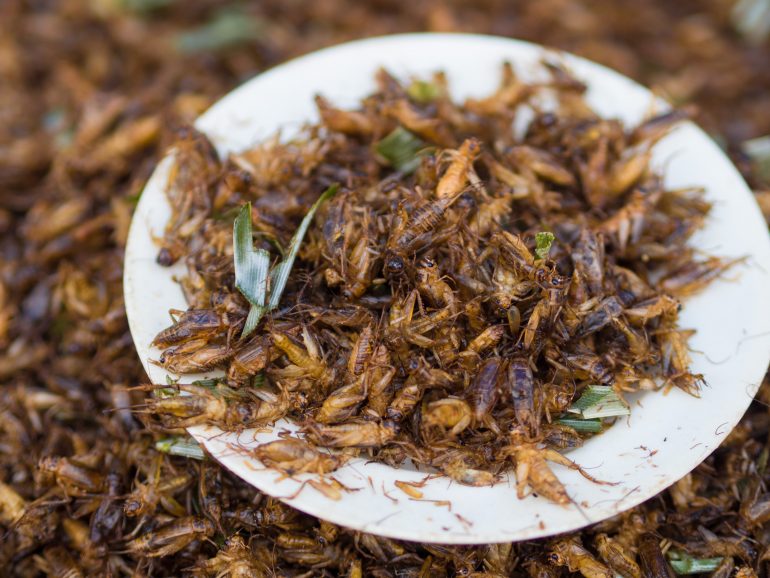We are currently at a very interesting point in the evolution of our food system. On one hand, more and more people are seeking to connect to their food in a more wholesome, natural, hands-on way, as the trends of home-harvesting, organic foods, and farm-to-table initiatives are suggesting. On the other hand, some pioneering science, such as lab-grown meats, low-cost DNA sequencing, and nanobots, are in many ways disrupting our comprehension of what really defines “food.” Simultaneously, we are rekindling our passion for unaltered, simple ingredients and all their richness, and are engineering our way into creating our own food in a synthetic, almost mechanical manner, with some never-before imagined potential.
We will need to feed 9 billion people by 2050. In order to support this radical increase in protein need, crop production would need to double.
At the core of both these trends, technology will play a central role. In one instance, it will help citizens access fresh foods more readily and at a cheaper cost, and in the other it will enable scientists to mimic nature and reshape altogether the way we see, feel, and consume food. In both cases, these two seemingly divergent philosophies are both accelerating a shift towards a more abundant, healthy, and sustainable food system, which is timely since our current food system is broken in many ways.
In fact, as a 2013 United Nations report on food sustainability as demonstrated, our global food supply will be challenged over the next decades by a growing population, combined with scarce natural resources and limited potential for agricultural expansion. It is estimated that we will need to be able to feed 9 billion people by 2050. In order to support this radical increase in protein need, crop production would need to double; this is simply unsustainable. To meet the food and nutrition challenges of today and tomorrow, what we eat and how we produce it needs to be re-evaluated; alternative solutions to conventional livestock and feed sources urgently need to be found. Moreover, our current food system is a leading cause of global warming and pollution (the greenhouse gases produced by cattle alone are equivalent to all of the exhausts from all modes of transport combined).

At Wilder & Harrier, our mission is to accelerate the transition towards an abundant and sustainable food system by using radically sustainable proteins. In 2015, with the motivation to find alternative ways to eat well while using resources in a much smarter way, we fell upon a surprising, yet logical solution: edible insects. Insects simply make sense — as do a lot of other revolutionary protein sources currently ignored by the industry. For example, crickets use, pound for pound, 2,000 times less water, 13 times less feed, and produce 100 times less greenhouse gases than beef. That being said, we were also very conscious that cultural adoption of insects and other non-conventional ingredients in the West would be a crucial market barrier. With this in mind, we decided to focus on the pet food industry, which is in dire need of innovation and where the end customer is bias-free. W&H’s first product is a line of oven-baked dog treats made with cricket protein – a sustainable and nutritious superfood.
Our hypothesis was the following: by removing people as consumers and creating products for their pets, we would be able to bypass the psychological barriers limiting food innovation, and accelerate the adoption of insect-based products and other non-conventional ingredients. After initial customer feedback, our hypothesis was quickly confirmed. Although many pet owners said that they would not be ready to eat insects themselves, they had absolutely no problem feeding them to their dogs, if it was good for them and for the planet.
By removing people as consumers and creating products for their pets, we could bypass the psychological barriers limiting food innovation and accelerate the adoption of insect-based products.
At the core of our quest to integrate radically sustainable ingredients, cultural acceptance remains a crucial challenge. Food entrepreneurs like us must find creative ways not only to innovate by uncovering or engineering the most sustainable foods, but also in the ways they facilitate the adoption of those foods. At W&H, the bet we took was that pets could actually help us, without even realizing it, to accelerate the adoption of unconventional and eco-friendly ingredients. What other ways can we accelerate cultural adoption of sustainable proteins? We believe that this question is as crucial as ever.
Presently, crickets represent the most sustainable alternative. But as previously discussed, the ways in which we can move towards a sustainable food system are various. As food innovators, we believe we must be not only aware of current novel ingredients, but we must also be able to combine the two seemingly divergent food innovation trajectories previously discussed and anticipate how they will shape our food system.
Food startups like ours need to be aware and leverage those trends to innovate in a sustainable way. In order to do that, we must be driven simultaneously by a respect of the natural order of biology and by technology. If we manage to merge those two seemingly divergent concepts, we will be able to effectively mimic and support how our ecosystem uses, converts, and transforms energy and matter to feed us all. If we manage to find the right balance between these two innovation trends, ultimately in 150 years, when it comes to our food system, we will not be able to differentiate between nature and technology.
Discover more predictions on the next 150 years of tech at whatsnowwhatsnext.ca.

